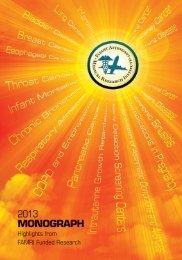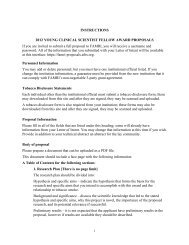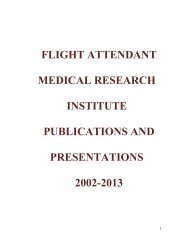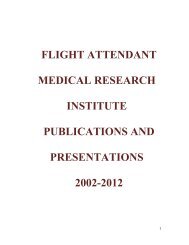MISSION
2009 compendium of FAMRI-supported research - Flight Attendant ...
2009 compendium of FAMRI-supported research - Flight Attendant ...
You also want an ePaper? Increase the reach of your titles
YUMPU automatically turns print PDFs into web optimized ePapers that Google loves.
flagellin, released from commensal and enteroinvasive microbes in the human gut, stimulates Toll-like<br />
receptor 5 (TLR5) leading to proinflammatory responses and activation of PI3K in colonic epithelial cells.<br />
However, the molecular mechanisms by which TLR5 activates PI3K have not been well investigated. In<br />
this study, Dr. Rhee determined the signaling pathways involved in flagellin/TLR5-induced PI3K<br />
activation in human colonocytes. In order to determine PI3K activation in vitro, expression of TLR5 or its<br />
adaptor molecule, MyD88, was silenced by stable transfection of TLR5 or MyD88 siRNA constructs,<br />
respectively, in non-transformed NCM460 human colonocytes. Several TLR5 mutants harboring pointmutated<br />
tyrosine residues, including SH-2-domain binding motif ‘YXXM’ in the cytoplasmic TIR domain<br />
of TLR5, were generated by site-directed mutagenesis. Co-immunoprecipitation assays were performed to<br />
determine the association between TLR5 and MyD88 or PI3K.<br />
The investigators showed that flagellin exposure to NCM460 cells transiently activated PI3K within 10-<br />
30 min, while blocking PI3K reduced IL-8 production in colonocytes. TLR5 silencing blocked PI3K<br />
activation by flagellin, indicating that TLR5 specifically mediates PI3K activation in colonocytes.<br />
Immunoprecipitation studies showed that TLR5 recruits the p85 regulatory subunit of PI3K to its<br />
cytoplasmic TIR domain following flagellin stimulation, and MyD88 interacted with TLR5 in a timedependent<br />
manner. Additional immunoprecipitation studies with TLR5 mutant constructs demonstrated<br />
that the SH-2 binding ‘YXXM’ motif in the TIR domain of TLR5 is not involved in p85 recruitment,<br />
implying that p85 is indirectly recruited to TLR5. Moreover, silencing MyD88 expression in colonocytes<br />
disrupted PI3K activation and blocked the association between TLR5 and the p85 regulatory subunit.<br />
Thus, PI3K activation in TLR5-associated signaling in human colonocytes is MyD88-dependent.<br />
ROLE OF SERPINB1 IN CIGARETTE SMOKE-INDUCED DEFECTIVE ANTIMICROBIAL DEFENSE<br />
Charaf Benarafa, DVM, PhD; Immune Disease Institute; YCSA 2008<br />
Oxidative damage induced by SHS leads to cellular injury and inflammation in the lung and these events<br />
are associated with increased risk for pulmonary infection. The direct effects of repeated smoke exposure<br />
and the additional burden produced by recruited leukocytes that release proteases, oxidants and<br />
inflammatory mediators on the lungs, can cause dysregulation of the immune response to pathogens.<br />
SERPINB1 (also known as monocyte neutrophil elastase inhibitor, MNEI) is an ancestral member of the<br />
serpin (SERine Protease INhibitor) family and one of the most potent inhibitors of the neutrophil serine<br />
proteases: elastase, cathepsin G and proteinase-3. Dr. Benarafa and collaborators have recently developed a<br />
model of protease-antiprotease imbalance by deleting the mouse gene. Serpinb1-deficient (serpinb1-/-)<br />
mice have a late-onset defective immune response to acute Pseudomonas aeruginosa infection and fail to<br />
clear the infection due to increased neutrophil death and proteolysis of surfactant protein-D (SP-D). Dr.<br />
Benarafa hypothesizes that SERPINB1 participates in the protection of cellular and molecular antimicrobial<br />
mechanisms dysregulated by the oxidative and inflammatory damage induced by cigarette smoke. To test<br />
this hypothesis, the scientists are investigating: 1) whether oxidative damage induced by exposure to<br />
cigarette smoke affects SERPINB1 expression in lung cells in vitro and in vivo; 2) whether the<br />
combination of oxidative injury of cigarette smoke and the antiprotease defect of serpinb1-/- mice<br />
increases the susceptibility to subacute bacterial lung infection; and 3) whether recombinant SERPINB1<br />
preserves the innate immune response to P. aeruginosa infection in wild-type mice exposed to cigarette<br />
smoke. These studies are to define a role for SERPINB1 in regulating damage caused by cigarette smoke<br />
components, and protecting molecular and cellular components of the healthy lung innate immune<br />
response. Importantly, inhaled recombinant SERPINB1 may be considered as a possible adjunct treatment<br />
in cases of pulmonary exacerbation caused by bacterial infection in COPD patients.<br />
THE INFLUENCE OF SECOND HAND CIGARETTE SMOKE ON THE INNATE IMMUNE FUNCTION<br />
OF NASAL EPITHELIAL CELLS.<br />
James A. Jukosky, PhD; Dartmouth College; YCSA 2008<br />
Adults and children exposed to SHS have an elevated risk of developing chronic sinus and bronchial<br />
infections, asthma, and allergies. This suggests that cigarette smoke (CS) has adverse effects on immune<br />
defenses. The goal of Dr. Jukosky’s study is to understand which innate immune responses are altered by<br />
CS exposure. Epithelial cells are the key to innate immunity and the first line of defense against infection.<br />
Airway epithelial cells form a physical barrier, but also respond to the presence of microbes by secreting<br />
antimicrobials, cytokines and chemokines. These molecules can neutralize infectious microorganisms<br />
and/or provide signals critical to the initiation of adaptive immune responses. Preliminary results show<br />
that aspects of innate immune protection provided by nasal epithelial cells are altered by CS exposure. Dr.<br />
Jukosky’s data demonstrate that nasal epithelial cell secretion of CCL20, (a protein that has antimicrobial<br />
P A G E 1 9 3







